Menus
- Seriously wanton !
- The BMW S 1000 R, the “string and tall handlebar” version of its in-house superbike, has strong arguments to make a place for itself in the sun in the hotly contested Streetfighters segment: proven cycle part, comfortable 160 horsepower and – this is the biggest surprise – a downright competitive…
- Presentation
- In the saddle
- In the city
- Motorway and expressways
- Departmental
- Duo and accessories
- Conclusion
Seriously wanton !
The BMW S 1000 R, the “string and tall handlebar” version of its in-house superbike, has strong arguments to make a place for itself in the sun in the hotly contested Streetfighters segment: proven cycle part, comfortable 160 horsepower and – this is the biggest surprise – a downright competitive price !
The times are changing ! It wasn’t that long ago that sports roadster enthusiasts didn’t have much to eat. A Ducati Monster here, a Triumph Speed Triple there, then there was the Kawasaki Z 1000. And there everything changed. All the manufacturers have started to integrate a “nasty thing” into their range with varying degrees of success..
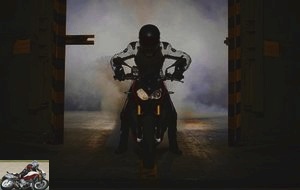
Aprilia has even taken it a step further by appropriating the current Streetfighter tuning with the Tuono. The idea is simple, we take a superbike, we turn the fairing and we stick a large handlebars to it. If the concept did not hit the charts (a sports car is expensive, even without a fairing!), It has gained ground and this sub-category now counts in its ranks, in addition to the Tuono, the Ducati Streetfighter, the Yamaha FZ1 and hybrids like the KTM Superduke 1290 R and the MV Agusta Brutale (s) … At BMW too there has been change. Since 2004 and the major operation to rejuvenate its image and its customers initiated with the K 1200 S, the Bavarian firm has not stopped investing in new niches. It was therefore logical that after sports cars, mid-engines and scooters, we saw a Streetfighter version of the S 1000 RR tumble down. !
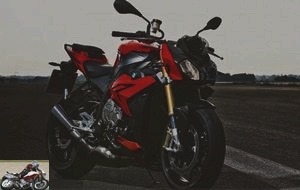
Presentation
At first glance, one might imagine that producing a Streetfighter is simpler than starting from a blank slate to produce a radical roadster. Not at BMW. Just the choice of engine power – easy when you start with a base of 193 horsepower – has been debated internally. Early development models were 135 cannons and the threshold of 160 was defined as the “reasonable” maximum for this machine. It must be said that our German friends do not mess with security. Fun, yes, but not too much anyway.
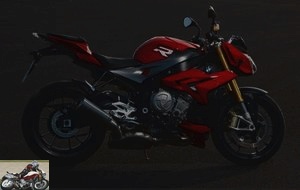
By caricaturing, the approach in the development is the opposite of the “dilapidated de le teute” neighbors from KTM who started from an overpowered and uncontrollable prototype to make the Superduke 1290 R … However, we can not to say that BMW did the job halfway. The four-cylinder in-line has been extensively revised to adapt to the specifics of a typical roadster driving style. Maximum power is reached at 11,000 rpm (breaker at 12,000 rpm) against 13,000 on the sports car and the torque curve is much more full (see comparative table) despite an identical absolute value (112 Nm). Up to 7,500 rpm, the engine delivers 10 Nm more than on the S 1000 RR. To achieve this, BMW has, among other things, redesigned the intake ducts, changed the profile of the camshafts and readjusted the engine management unit accordingly. The ride by wire is retained, as is the anti-dribble clutch.
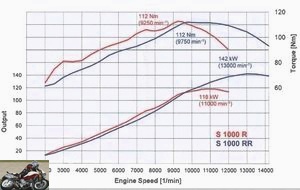
The chassis is also entitled to its share of modifications. The inverted fork of 46 mm in diameter is entitled to a steering damper and sees its caster angle close by 0.8 ° while the caster goes from 93.5 to 98.5 mm thanks to new T fork and a revised anchor point at the level of the oscillating arm. To improve stability, the wheelbase has been seriously revised upwards (+ 22 m). Most of this gain comes from switching to a longer chain. We can raise some objections as to the lifespan of the said chain. Our testing machines, new, were already almost at the end of their travel on the chain-to-wheel chain tension adjustment, leaving a little less than 2 cm of adjustment before reaching the end of the swingarm … Why not ! It must be said that making a specific swing arm would have increased the weight as much as the note. And since the S 1000 R weighs only 207 kg and costs “only” 12,950 € (against 17,400 € for an RR), we will pretend not to have seen anything.
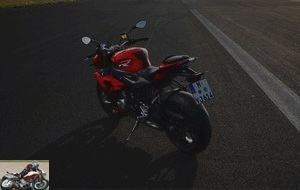
For that price, you will surely tell yourself that all electronic assistance has gone by the wayside, ABS included. In fact yes and no. The original equipment includes ASC traction control as well as the partially integral in-house Race ABS. And the pilot has access to two "riding modes": Road and Rain. The latter lowers power to 136 horsepower and torque to 104 Nm while offering a significantly smoother throttle response without forgetting specific ABS and ASC settings. To unlock the full potential of the S 1000 R, it will be necessary to subscribe to the option "Pro piloting mode" (345 €) which replaces the ASC by the DTC (still a traction control, but here coupled to a gyroscope detecting the catch. , angle) and gives access to two additional piloting modes: Dynamic and Dynamic Pro. In Dynamic, you are entitled to a raised intervention threshold of the Race ABS at the front and rear (take-off of the rear wheel allowed to a certain extent) and a less intrusive traction control. The Dynamic Pro mode gives you the all-rounder. ABS is deactivated at the rear, DCT is set to its lowest intervention level, and wheeling and stopping are enabled electronically. BMW has also incorporated a shifter (€ 370) and DDC Damping Dynamic Control (€ 655) recently introduced on the HP4, a kind of self-adaptive electronic super suspension coupled with driving modes.
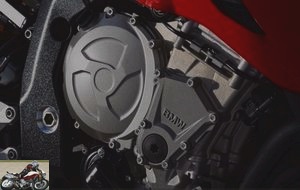
In the saddle
Let’s move on to the overall design – this is a RR in string – which remains in full compliance with the spirit of the house: the headlights of the fork crown are – as usual – asymmetrical, just like the design of the radiator scoops. The overall finish is excellent and nothing annoys the eye. The saddle, lower by 6 mm (814 mm) allows both feet to be flat (heel slightly off) from 1.70 m and the driving position is more in line with sporty roadster standards than streetfighter, i.e. tilted without excess on the front and with the legs sufficiently loosened thanks to the footrests advanced and lowered by 23 mm. The dashboard, taken directly from the S 1000 RR, is exhaustive. In addition to the analog tachometer, the usual warning lights (reserve, indicators, etc.) and the adjustable shiftlight, the numeric keypad can display the following information: speed, gear engaged, driving mode, total mileage, engine temperature, fuel level , remaining autonomy, the hour, 2 trips, consumption and average speed, as well as an interface dedicated to the track capable of displaying its lap times as well as the best current lap. Depending on the configurations chosen (our test machines were "full option"), we can also obtain information on heated grips, DDC suspensions and cruise control.
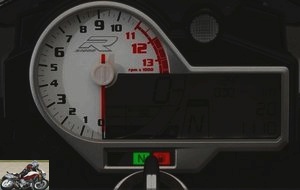
The good news is that EVERYTHING can be fully manipulated without ever letting go of the handlebars: driving modes, DDC, heated grips … The other side of the coin is that the stems on the handlebars seem to have had an acne breakout with pimples in all directions … Fortunately, the ergonomics are well thought out and after twenty kilometers, we instinctively find the pimples without taking your eyes off the road. After this avalanche of positive points, it should be noted that the stupid clutch lever, devoid of adjustment (unlike the brake) and a bit too far away, is a bit stain in the picture. Evil tongues will say that it is only there to encourage the buyer to fall back on the shifter.

In the city
From the start, the R gives voice. The sound of the four is hoarse, coated in a metallic tone and above all particularly present. A few gas shots confirm this first impression, the German engineers have let themselves go to the minimum sound level and that’s good.
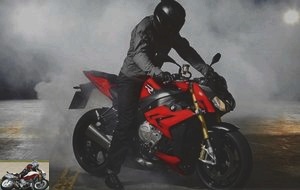
Our route, drawn on the small island of Mallorca, takes us through the town center of Cas Catala to reach the motorway. And with a temperature oscillating between 5 and 10 degrees plus a local bitumen not known for its grip, the first kilometers are done carefully. With a full weight of close to 200 kg and a large handlebar, you would expect a machine that is super crisp on the corner and terribly agile in small corners. But that’s without counting on the steering damper. Well braked (too much?), It adds a little artificial gravity to the whole, making it look like a ballerina in Rangers. Pity. A higher ambient temperature should improve that but we clearly feel that the impetent is not there to look pretty.
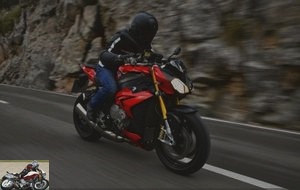
The S 1000 R doesn’t like traffic jams either, or just on the main roads. Logically, if it must inherit the qualities of the sportswoman, it also takes up certain faults such as a turning radius like a super tanker. For the rest all is well. With just 500 km on the clock, the gearbox is a little firm, but the flexible engine (30 km / h in 6 ° a hair above 1000 rpm) and the excellent rear wheel gas connection put in trust. Even the shifter does it its own, accepting the on-the-fly changes at low revs and low load unlike an Aprilia Tuono. The brakes, which are very biting, will take some adaptation time before they master a smooth slowdown. Luckily the ABS is on the lookout, almost too much when we switch to Rain mode, with nuisance tripping at the rear with our mixed weather. The traction control (DTC in our case) is transparent and very effective. The bulb on the dashboard signifying its entry into action has come on several times without you feeling its action on the handlebars.
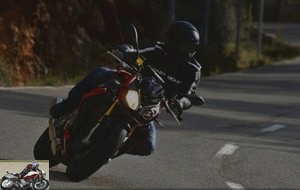
Motorway and expressways
Carving the road with a Streetfighter is never easy. We put our necks to pieces as soon as we exceed the legal limits. Suddenly after ten terminals, the cruise control option offered by BMW is not as incongruous as it seems. And then at least on the S 1000 R, the saddle is relatively comfortable and the DDC suspensions adjusted to the most flexible erase the imperfections of the Spanish asphalt very well. At 130 km / h, the four-cylinder purrs at 5,750 rpm and 120 km / h, BMW announces a consumption of 5.6 l / 100 km which gives the R a theoretical range of 310 km. For my part, I never went below the 7.5 l bar (combined consumption) with an on-board computer announcing a range of action slightly greater than 230 km. As for the stability at high speed, it is almost irreproachable. The machine is not to be directly questioned, the “big ones” all praised the stability of the machine but with a small template like mine (170 cm), the seat backrest is too far back to take support when of (very) strong accelerations. Ditto for the footrests, too advanced to counter the acceleration. Suddenly we can only cling to the handlebars which induces in the direction of parasitic movements.
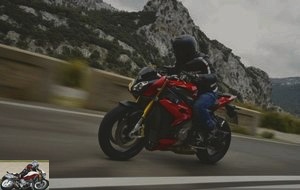
Departmental
You might as well tell you right away, between the gloomy weather, several showers and a temperature that kept going down (we even had a little snow on the side of the road) as much to say that the atmosphere does not was in unbridled arson and conditions not ideal for determining the behavior of the S 1000 R at a sustained pace.
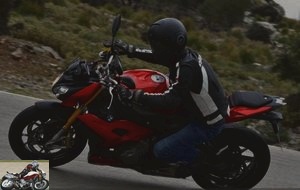
The engine, on the other hand, is a treat of torque, power and ease, all wrapped up in a sound that’s as present as it is pleasant. The Rain mode, tested on driving rain and an ice-rink type road, was particularly reassuring with an ultra-smooth response on the first degrees of opening while maintaining a comfortable reserve of power when needed. The same goes for the anti-skid ABS duo, precious allies (and several times involuntarily called upon) remarkable efficiency. And to compensate for the pronounced bite of the double radial front disc, the “just one finger” option was necessary on its own. Paradoxically, on a dry (and cold) road, Dynamic Mode is the most pleasant with its more aggressive ABS setting. The one in Road mode, combined with warm tires, tended to fire too early and too often. The Dynamic Pro mode is a little too brutal when the throttle reopens in view of the precarious grip…
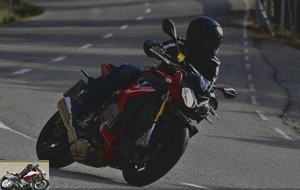
As for the engine, it is three-sided. Soft and docile up to 3000 revolutions, it then enters a first muscular phase up to 6500 rev / min, threshold beyond which it explodes to climb towards the red zone before regulating to 10,000 rev / min while keeping enough extension up to the breaker (12,000 rpm) so that you don’t feel the need to change gear. Power, and especially torque, makes the front lift on its own in the first two gears. During acceleration, the optional shifter is a treat to use. Just keep the throttle wide open and upshift. Everything goes smoothly and quickly and each climb is punctuated by a mini explosion when the unburned gasoline when the ignition is switched off explodes as it arrives at the exhaust outlet. On the chassis side, the results are more vague. The large handlebars limit feedback and the tires, however Pirelli Diablo Rosso, never seemed to want to heat up, causing several losses of front axle grip. By switching to a soft suspension setting, things improve a bit thanks to more marked mass transfers. Angle setting and direction changes become healthier and smoother, but the front end always stiffens slightly when entering a turn on the brakes or when braking on the angle. These impressions are to be put in the conditional. Given the grip conditions, forcing the front axle by counterbraking or adding weight on the inner footrest to analyze the phenomenon more clearly was a challenge.
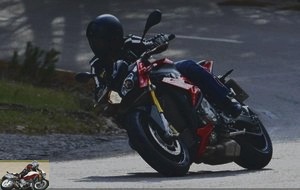
Considering the proven qualities of the RR chassis, a test in milder conditions is in order to dispel this feeling. But it is certain that the obligation to “drive smoothly” means that we lose the benefit of the lever arm offered by the large handlebars, leaving only the inertia induced by the extended wheelbase and the shock absorber to show through. very conservative setting. Be careful, the S 1000 R is not an anvil either, but in view of its technical characteristics, handling seems to fall short of some of its direct competitors like the Superduke or the more virulent MV Agusta. Knowing the safety policy of the brand and the fact that the S 1000 R is intended to put its wheels occasionally on a circuit, it seems logical that BMW wished to promote stability to the detriment of liveliness. Conversely, the re-acceleration phases, on the other hand, are only an administrative formality once the most suitable mode for the grip has been found, the traction control taking care of managing the arrival of power for you..
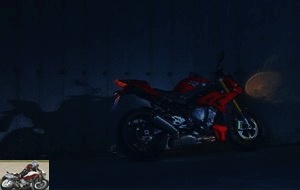
Duo and accessories
It’s hardly better than the RR so breakdown and short distances only. The advantage of the Streetfighter is that it shields the passenger from wind and weather … For masochistic (or very in love) spouses, BMW still offers an optional comfort passenger seat! For the S 1000 R, BMW has concocted two specific packs.
the Sport, charged € 800, including Shifter (€ 370), DTC (€ 345) and cruise control (€ 325).
the Dynamic Pack (€ 920) offers DDC suspensions (€ 655), heated grips (€ 215), an engine guard (n.c.) and white LED indicators (n.c.). The specific option list, two pages long, is modeled on that of the RR. We can mention a jumble of crankcases, an alarm, front and rear panniers, a GPS support, full of carbon parts, lighter or (even) noisier pots / lines, “comfort” screen and saddles as well as a plethora of pieces dedicated to the track…
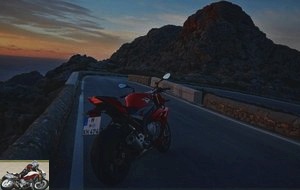
Conclusion
The S 1000 R can already count on three strong assets to make the difference against the competition: its engine (at least in full version) as pleasant to stroll about as demonstrative and effective on attack, its electronic assistance capable of playing the double role of safe stand AND performance booster and finally its price canon given its level of standard equipment. Especially since despite its Streetfighter label, this R should prove remarkably accommodating on a daily basis. There are still a few points to be clarified before clearly stating whether the S 1000 R is one of the benchmarks in the segment or simply THE benchmark. First, test the chassis under more favorable conditions, check the quality of the clamping outside the free world and test an entry-level version devoid of DDC and DTC in order to quantify the difference with a full option variation.
Strong points
- Flawless motor
- Quality of electronic assistance
- Powerful braking
- Price
- Versatility (within the limits of the genre)
Weak points
- Too much bite on the front brake
- Front axle heaviness
Datasheet
Related articles
-
4 cylinders in line, compressor, 998 cm3, 210 hp at 11,000 rpm, 137.3 Nm at 9,500 rpm, 260 kilos, € 21,999 Kawasaki reinvents the super-fast and…
-
BMW GS 1250 motorcycle test daily
Flat Twin ShiftCam of 1,254 cm3, 136 hp and 143 Nm, 249 kg full made, from 17,599 euros Daily test for 15 days Already more than 800,000 big GS sold in…
-
The best, quite simply 998 cc V4, 221 hp (234 hp) and 112 Nm, electronics and ride-by-wire, aerodynamic fairing, 193 kg full facts, 39,900 euros 2019…
-
Moto Guzzi Nevada Aquila Nera test
A world of sweetness Charming in its black dress, the 750 Nevada is beautiful but wise for a 750 twin. A Moto Guzzi-style custom, that is to say that…
-
Honda CRF 250 L motorcycle test
A little trail that sparkles The great Escape You don’t like small cars? So be sure to read this article! Because after discovering this new Honda, you…
-
BRP Can-Am Spyder RS and RT Test
Horse of three ! The Can-Am Spyder, an astonishing automobile front-end trike, is celebrating its 5th anniversary this year. The opportunity for us to…
-
MV Agusta Rush 1000 motorcycle test
0 to 100 km / h in 2.9 seconds! All in excess ! 4 cylinders in line, 998 cm3, 212 hp and 116.5 Nm, 186 kg dry, 300 copies, 34,000 euros The success of…
-
Yamaha VMax 1700 motorcycle test
The return of a legend The return of the good, the bad and the tonic-truante. Certain celestial objects cross our orbit according to a periodicity which…
-
Triumph Bonneville Bobber Black test
2 cylinders in line, 1200 cc, 77 hp at 6100 rpm, 106 Nm at 4000 rpm, 237.5 kilos dry, from ¤ 14 350 More muscle, more techno, more dark for the Bobber Is…
-
200 hp at 13,500 rpm, 112 N.m at 11,500 rpm, 199 kilos with full fuel, from € 18,499 Is the Crossplane engine an advantage in road use ? Even if the…